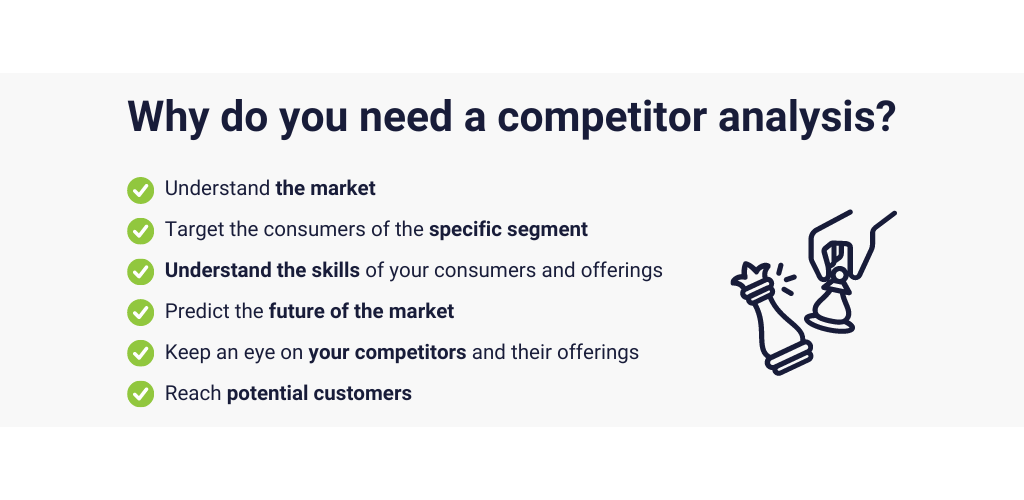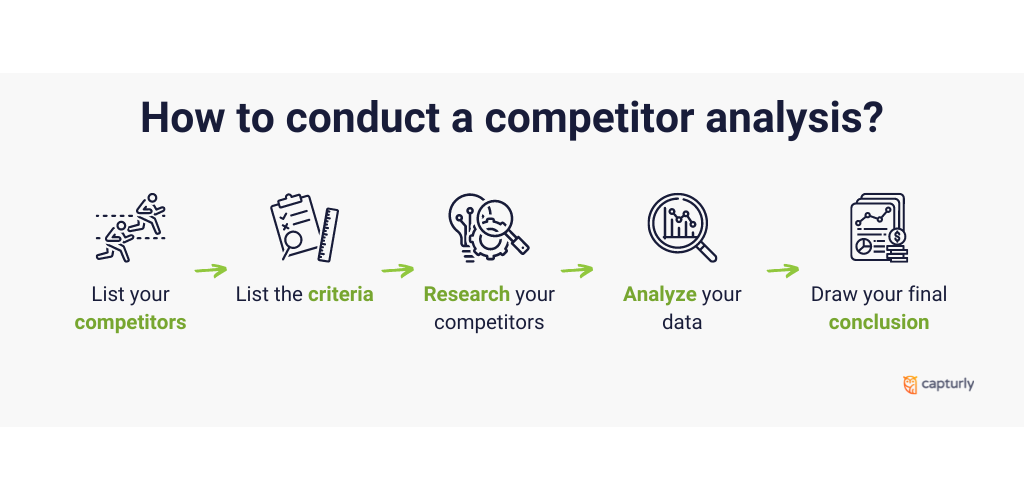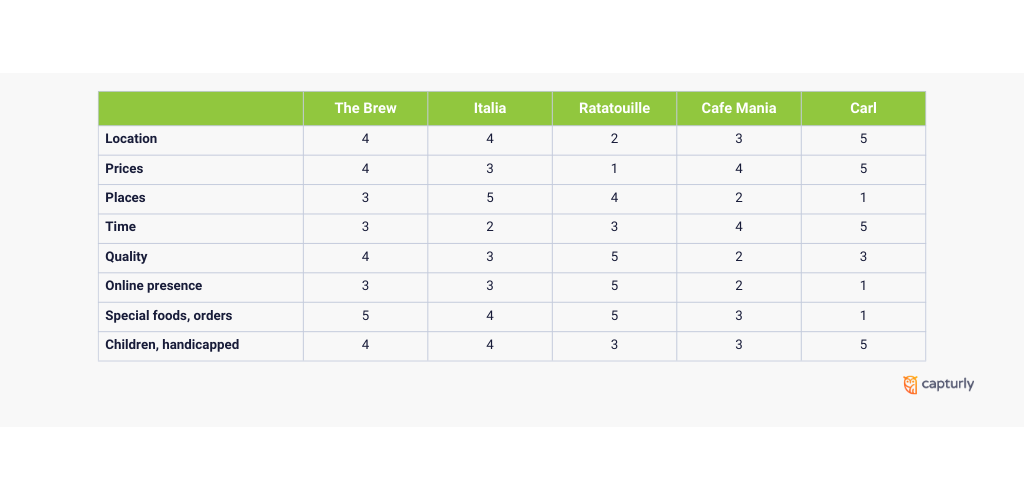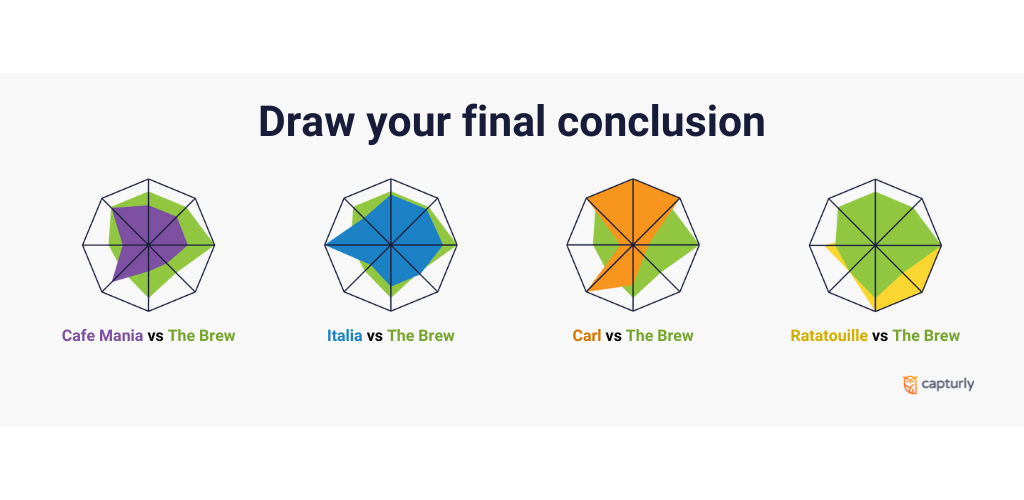Updated: 2023-12-08
Are you getting ready to start a business or launch a new product? If you’re squeezing in reading articles between back-to-back meetings, hold on a minute. Make sure you read this first!
💡 Think about it: You’ve got this great idea that could really make a difference in your life or maybe even in the world. It would be such a waste if it didn’t work out just because you missed something important at the start.
The first thing you should do is check out your competition. Knowing what they’re good at and what they’re not so good at is super important. This is just one of the steps to help make sure your business is on the right track from the get-go. Let’s get into it!
Table of Contents
Why do you need a competitor analysis?
Let’s ask a simple question: Why do we need oxygen? Well, it’s vital for our survival, right? In the same way, do you know what’s essential for your startup or new product to thrive? It’s a competitor analysis!
Having a well-structured analysis in your hands can help you to:
- understand the market that you are about to enter (and the competition too)
- target the consumers of the specific segment
- understand the skills of your consumers and offerings
- predict the future of the market
- keep an eye on your competitors and their offerings
- reach potential customers
And that’s just the start! With a solid competitor analysis, you’re not just guessing; you’re making smart, informed decisions for your business. Let’s dive into how you can make your company strong and ready to succeed, even before you launch.

Who should do the analysis?
You have two options by default. You either hire someone or you can analyze by yourself.
Hire someone else to analyze competitors
Here’s something to think about: Expert analysts have worked on dozens, maybe even hundreds, of projects just like yours. They’ve got the experience and routine down to an art. Chances are, they’ll bring up points and ideas you might not have considered initially.
It’s amazing what a fresh pair of expert eyes can see that we might miss. These professionals can provide insights that could be game-changers for your business. So, as you’re getting ready to launch your company, let’s explore how tapping into expert knowledge can be one of your smartest moves.
Analyze competitors by yourself
Are you comfortable sharing all the details of your business with someone you don’t know well? Think about it – you’re the expert on your business, more than anyone else, stranger or not. Why would someone else know your business better than you?
It’s important to remember that you have the most valuable insights about your company. Trust in your own knowledge and instincts as you make decisions. This is your venture, and nobody understands it like you do. Let’s explore how you can use your unique perspective to build a solid foundation for your business, even before it officially starts.
How to conduct a competitor analysis?
In the following 5 steps, we take a look at how to start a business to make it successful.

STEP 0 – Have a startup, a new product or anything that needs a competitor analysis
My example in this article will be a restaurant called The Brew that I am about to open in a small town called CompetiTown.
STEP 1 – List your competitors
The first step in a competitor analysis is to list your competitors. But watch out! You need to sit down and think about this for a while.
Two types of competitors can be distinguished:
- Direct competitors can be other restaurants in CompetiTown, especially those which are in your given area (however, those outside the area can be important too). These competitors sell the same things that you intend to.
- Indirect competitors don’t sell the same products, but substitutes of yours. In this given situation, even the old man selling hotdogs in front of your restaurant can be considered as a competition of your business.
My list has 4 competitors:
- Italia: an Italian restaurant in the downtown
- Ratatouille: a fancy French restaurant in the outer parts of the town
- Cafe Mania: a coffee shop near our restaurant
- Carl: ‘the wingman’, selling chicken wings from his mobile buffet
STEP 2 – List the criteria used for competitor analysis
Alright, you’ve got your list of competitors. That’s a great start! The next step, which can be a bit challenging, is to create a list of criteria to rate them. You’ll also need to decide how to score your competitors.
Choosing the right scale for scoring can be a bit tricky. You don’t need a scale with a ton of points, but you should have at least three to make it useful. In this example, let’s go with a 5-point scale. This is enough to show the differences between the competitors without being too complicated.
💡 Remember: the higher the score, the better it is for the customer. Let’s dive into how you can use this scale to really understand where your competitors stand and where your business can shine!
After having a brainstorming session, you should have all your relevant criteria on a piece of paper.
My list consists of 8 criteria:
- Location: Is it close to the center or is it in the worst part of the town?
- Prices: Do you need 3 credit cards to buy an appetizer or you can have a decent meal for a couple of bucks?
- Places: How many seats and tables does the place have? Does it have seats at all?
- Time: How long does it take to have your meal on the table? Hours? Minutes?
- Quality: Have you been waiting for that delicious shrimp pasta for over a month? Or you just bolted down that greasy hamburger?
- Online presence: Do they have advertisements, a Facebook page, a website or an application?
- Special foods, orders: Can you have a pizza made from gluten-free flour? Can you order a smaller portion or a kid menu?
- Children, handicapped: Do they have a special place and programs for children? How easy it is for a handicapped person to get into the building and have a night out?
STEP 3 – Research your competitors
Wondering how to figure out how many points to give each competitor? The best way is to see for yourself. If you can, try their product or service.
If that’s not possible, ask someone you trust to try it out and give you their honest opinion. And if neither of these options work, there’s a third way. Reach out to customers in your niche through interviews or surveys to get their take.
After a thorough analysis, it’s time to sit down and start scoring each competitor. But here’s the tricky part: scoring your own business. It’s super important to be honest.
Score yourself in the same way you scored the others. If you give yourself scores that are too high and not realistic, it could lead to problems down the road. Let’s dive into how you can do this effectively and fairly.
The result was this table:

STEP 4 – Analyze your data
Now you have your list with the points. It’s time to summarize your observations and lay down your conclusions. Write down every important information (later on you can choose which ones to keep).
1. Italia
Italia (the town’s only Italian restaurant) has several strengths and only one outstanding weakness.
Its biggest weakness is time. However they have freshly made pizza and pastas, it takes relatively much time to be done.
Italia compensates this with having the most seats from all of the available restaurants. The other criteria are not so outstanding: they are fairly similar to The Brew.
2. Ratatouille
Ratatouille is a French restaurant, famous for its quality and history. (The legend says that many famous people were guests here.)
Everybody in the town knows that its biggest disadvantage is its price. (Although after a while this usually becomes more tempting, because of its prestige.)
However it is fairly far from the center (it was in the center by the time it was built, but the town has been rebuilt since then), the restaurant’s quality, diversity, and own mobile application makes it the most popular restaurant of the town.
3. Cafe Mania
Cafe Mania is a coffee shop near our restaurant. It’s not a restaurant, but they started selling sandwiches, hamburgers and fast foods last month, so they became our indirect competitors.
Their biggest strengths are price and time. You can get cheap food quickly.
Although it has weaknesses too: being a cafe, it doesn’t have many seats. Of course they don’t sell the best quality food, and they have almost no online presence (only a badly managed Facebook page).
4. Carl
Carl is a middle-aged man, he has a mobile buffet car, he’s been selling wings since his childhood. He inherited the business from his father.
According to our analysis Carl has some extreme points.
He has a huge advantage, because he is mobile and he is also cheap and quick.
His weaknesses are: he doesn’t have seats at all, he doesn’t have online presence (not even in the local newspaper…time for an update, Carl!) and he cannot give you any special foods, because of his narrow menu. Besides that he doesn’t pay attention to allergens at all.
STEP 5 – Draw your final conclusion
Now you have every single thing in your hand, all you have to do is to analyze your data.
My method is creating net charts (with colored areas to make it even more visual), because it doesn’t matter if you do it for yourself or you have to present the results to a bunch of stakeholders.
Not everybody can understand tables full of numbers, but it’s easier for them to visualize the data this way.
In this particular example, I made 4 different net charts, each one representing the competitor’s and my own points.

Conclusions
What can we do to be better than the others?
- We don’t have as many seats as Italia does, but we don’t need as much time as they do. Keeping up this pace should be good.
- Our online presence is not too satisfying at the moment, but we can work on that (appearing on social media sites, local ads etc.). Who knows, one day we might have our own application too.
- Paying more attention to the children and handicapped can also be profitable, and it doesn’t take too much effort (unless we have to reconstruct the whole building).
- Improving our quality and serving special foods (creating several options without allergens and meat for example) can also be an option, if it’s possible for our budget.
And the list goes on and on… Do you have anything to add? Feel free to leave a note. 🙂
Don't forget, sharing is caring! :)


6 Comments
Jimmy
2017-01-05 at 10:07I am sure this post has touched all the internet people,
its really really nice post on building up new web
site.
Robert
2017-01-23 at 11:38Thanks Jimmy! Hope you’ll like the future contents. Cheers!
Varun Sharma
2019-07-11 at 11:58Wow, It’s an amazing post. I really like your post. Thanks for sharing with us!!
Robert
2019-07-31 at 09:15Hi Varun, thanks for your comment 🙂
Ruchi Arora
2019-07-17 at 13:09Amazing post…thanks for sharing.
Robert
2019-07-31 at 09:16Thanks Ruchi!